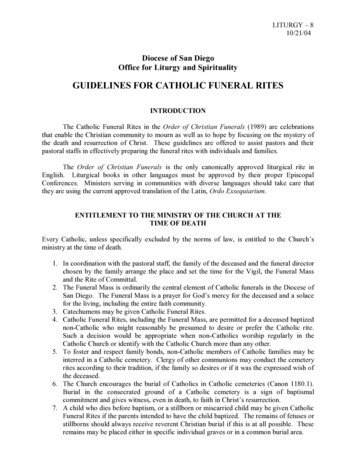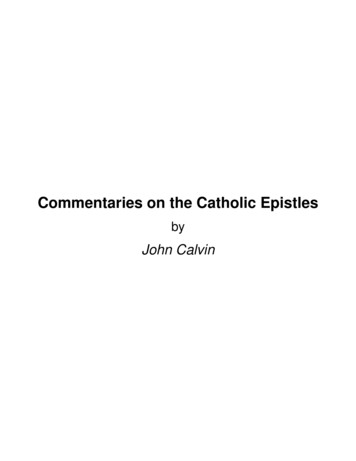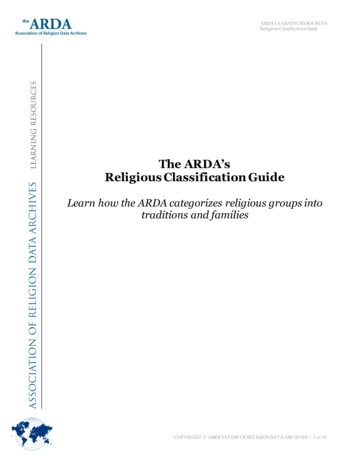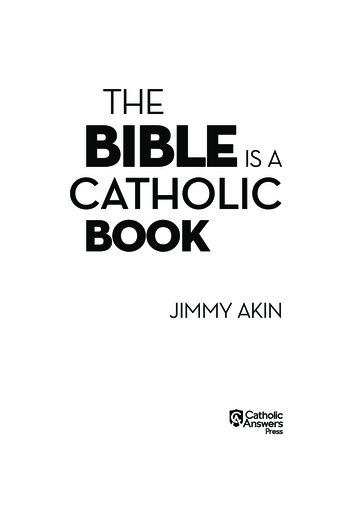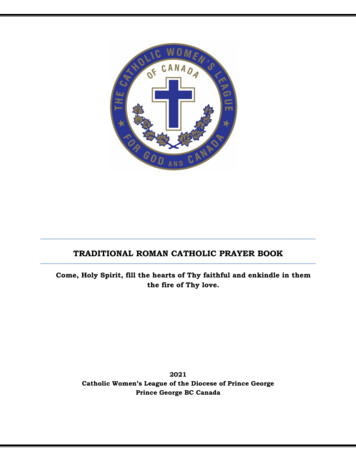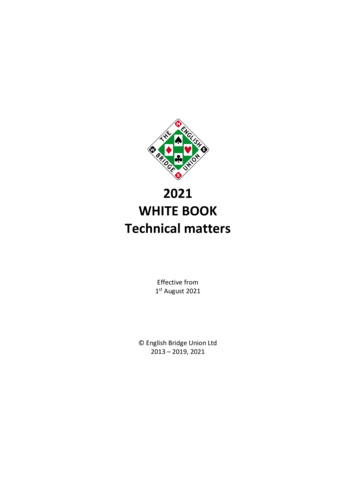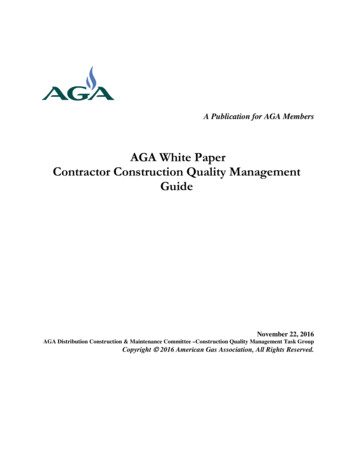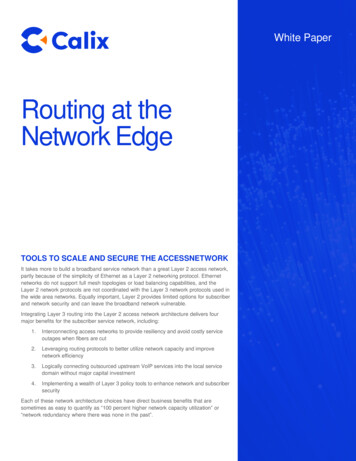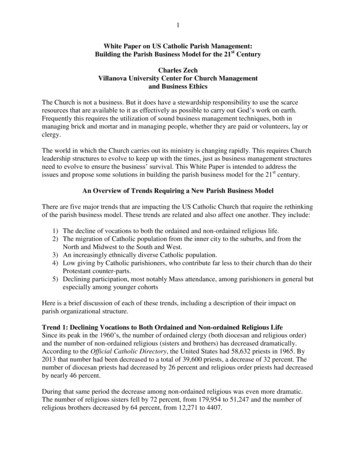
Transcription
1White Paper on US Catholic Parish Management:Building the Parish Business Model for the 21st CenturyCharles ZechVillanova University Center for Church Managementand Business EthicsThe Church is not a business. But it does have a stewardship responsibility to use the scarceresources that are available to it as effectively as possible to carry out God’s work on earth.Frequently this requires the utilization of sound business management techniques, both inmanaging brick and mortar and in managing people, whether they are paid or volunteers, lay orclergy.The world in which the Church carries out its ministry is changing rapidly. This requires Churchleadership structures to evolve to keep up with the times, just as business management structuresneed to evolve to ensure the business’ survival. This White Paper is intended to address theissues and propose some solutions in building the parish business model for the 21st century.An Overview of Trends Requiring a New Parish Business ModelThere are five major trends that are impacting the US Catholic Church that require the rethinkingof the parish business model. These trends are related and also affect one another. They include:1) The decline of vocations to both the ordained and non-ordained religious life.2) The migration of Catholic population from the inner city to the suburbs, and from theNorth and Midwest to the South and West.3) An increasingly ethnically diverse Catholic population.4) Low giving by Catholic parishioners, who contribute far less to their church than do theirProtestant counter-parts.5) Declining participation, most notably Mass attendance, among parishioners in general butespecially among younger cohortsHere is a brief discussion of each of these trends, including a description of their impact onparish organizational structure.Trend 1: Declining Vocations to Both Ordained and Non-ordained Religious LifeSince its peak in the 1960’s, the number of ordained clergy (both diocesan and religious order)and the number of non-ordained religious (sisters and brothers) has decreased dramatically.According to the Official Catholic Directory, the United States had 58,632 priests in 1965. By2013 that number had been decreased to a total of 39,600 priests, a decrease of 32 percent. Thenumber of diocesan priests had decreased by 26 percent and religious order priests had decreasedby nearly 46 percent.During that same period the decrease among non-ordained religious was even more dramatic.The number of religious sisters fell by 72 percent, from 179,954 to 51,247 and the number ofreligious brothers decreased by 64 percent, from 12,271 to 4407.
2As disappointing as these figures are, they mask another trend, the aging of active clergy andvowed religious. Not only are there fewer of them, but they are much older.In fact, the only group that is growing is the ministry of permanent deacon, which was reestablished after Vatican II. The permanent diaconate didn’t exist in 1965. By 2013 it had grownto 17,325 ordained permanent deacons.What This Trend MeansSo, what are the implications of fewer ordained and vowed religious serving the church in theUnited States? There are three primary issues: First, in the case of priests, fewer of them in the face of an increasing Catholic populationmeans that more is expected from each priest. In 1965 the ratio of Catholics to priest was778 Catholics per priest. By 2013 that figure had risen to 1687 Catholics per priest. Keepin mind that the priesthood is aging, and that not all priests serve in parishes. As a resultparishes are getting larger. At the same time the church’s expectation that priests serveboth as the spiritual leader of the parish and as its temporal leader (Canon 532) places ahuge burden on these men. Second, the non-ordained vowed religious have always been an important, whileinexpensive, pool of labor for parishes. They’ve traditionally been a critical source forparochial school teachers and other vital parish ministries. Those positions still must befilled. More and more frequently they are now filled by professionally trained lay people,who deserve compensation from the parish in accord with their professional credentials.This places a burden on parish budgets. Third, in those areas where there is a relative shortage of priests some dioceses haveresorted to closing or merging parishes, resulting in larger parishes. Others have adoptedinnovative parish organizational structures that are permitted by canon law. These includemultiple parishes pastored by a team of priests (Canon 517.1); a parish administered bysomeone other than a priest, such as a deacon, vowed religious, or lay person (Canon517.2); and a single priest pastoring multiple parishes (Canon 526.1). According to theCenter for Applied Research in the Apostolate at Georgetown University the number ofUS parishes without a resident pastor has grown from 549 in 1965 to 3554 in 2013. Thesealternative parish structures require inventive approaches to parish management.Trend 2: The migration of Catholic population from the inner city to the suburbs, andfrom the North and Midwest to the South and WestThe graph below, downloaded from the Association of Statisticians of American ReligiousBodies website illustrates the varying growth of the Catholic population in different regions ofthe country. A similar pattern holds for the migration of Catholics from urban centers (wherethey had settled as immigrants) to suburban areas as their socioeconomic status improved in theperiod following World War II. For example, during the period 2000-2010, the urbanizedPhiladelphia County lost 23% of its Catholic population while suburban Chester County’sCatholic population grew by 50.9%. Likewise, in the Chicago Archdiocese, urban Cook Countylost 9.3% of its Catholic population while in suburban DeKalb County it rose by 13.9%. Thesame pattern held even in growing areas like the Southwest. In Texas, urbanized Dallas County
3lost 7% of its Catholic population while suburban Collin County saw its Catholic populationincrease by 23.7%.What This Trend MeansAs a result of these dual migrations, there exists a serious mismatch between the location ofCatholic facilities (primarily churches and schools) and the US Catholic population. As ageneralization, the facilities tend to be located in urban areas in the Northeast and Midwest,while the Catholic population is increasingly located elsewhere. Large urban dioceses are facedwith the need to close poorly-attended inner city parishes and schools while building facilities inthe suburbs. Meanwhile, dioceses in the South and West are building facilities as they try to copewith the explosive Catholic population growth. One consequence is that the new parishes that arebeing established are larger than has historically been the case, placing a burden on parishmanagement. This pattern also places a tremendous financial strain on all of the dioceses andparishes involved.Trend 3: An Increasingly Ethnically Diverse Catholic Population
4Immigration has led to an increasingly diverse US Catholic parish population. A 2012 survey ofUS Catholic parishes conducted by the Emerging Models in Pastoral Leadership Project foundthat from 2005 to 2010 the average proportion of Caucasians in parishes decreased by nearly 3percent while the number of Asian and Hispanic parishioners increased by 17 percent. Accordingto the 2010 CCSP-FACT random survey of Catholic parishes, a quarter of US Catholic parishescelebrate their weekend masses in more than one language.What This Trend MeansAt one time Catholic parishes in this country were relatively homogeneous, reflecting thepropensity for recent immigrants to settle in conclaves with others of similar ethnic backgrounds.This was compounded by the emergence of ethnic parishes and strictly enforced parishboundaries. These patterns are not as prevalent today. Parishioners can no longer be viewed as ahomogeneous group with similar needs for programs and religious services from the parish. Eachparish needs to make a greater effort to reach out to its parishioners and learn what their needsare and the extent to which the parish is meeting those needs. There needs to be more attentionpaid to individual parishioner needs.Trend 4: Low giving by Catholic parishioners, who contribute far less to their church thando their Protestant counterparts.This is not so much a trend as it is an on-going problem. Since the pattern was first discovered inthe 1970’s, Catholic households have contributed to their church at about half the rate as theirProtestant friends. During the last four decades the typical Catholic household has reliablycontributed 1.1 to 1.2 percent of its income to the parish. During the same time period, thetypical Protestant household has reliably contributed 2.2 to 2.5 percent of its income to itscongregation.What This Trend MeansMedian Catholic household income in the US is about the same as median Protestant household.If U.S. Catholic households simply gave at the same rate as their Protestant friends (notnecessarily tithing, but 2.2 to 2.5% of their income) US Catholic parishes would realize another 8 billion in revenue each year. Looked at another way, each U.S. Catholic parish would see itsannual collection revenues double. Parish management structures need to be established that willenable each parish to take advantage of the opportunity to dramatically increase parish revenues.Trend 5: Declining participation, most notably Mass attendance, among parishioners ingeneral but especially among younger cohortsA 2012 survey1 found that weekly Mass attendance ranged from 54 percent for those 70 years ofage or older (about 10 percentage points less than it had been in 1999) to 23 percent forparishioners younger than 25. Other measures of participation have also been decreasing, and aretypically much lower for younger Catholics than for older Catholics.While it has always been true that there has been a life cycle effect in religion -- youth tend to beless religiously involved than their parents and grandparents – the current pattern of decliningparticipation among cohorts is a relatively recent phenomenon.What This Trend Means
5The youth are the future of the Church. To the extent that young parishioners choose to notparticipate in parish activities at the same rate as their parents and grandparents marginalizesreligion and puts the survival of parishes at risk. Parish management structures need to beinstituted that will enable the parish to address the participation issue.Components of the Parish Business Model of the 21st CenturyClearly, in the face of these and other trends (e.g., increased use of technology) the parishbusiness model of the 21st century must be adapted. This is true whether the parish is organizedas a traditional parish with a resident pastor or as an “emerging model” parish without a residentpastor. In either case, the following components need to be incorporated.Component 1: An Elliptical Parish Organizational Reporting ChartFr. Thomas Sweetser SJ, the highly regarded parish consultant, has long argued for a revision ofthe parish reporting chart. The chart in most parishes, Fr. Sweetser has observed, can beillustrated by a circle, with the pastor as the circle’s focus2. The entire staff reports directly to thepastor and all decisions flow through him. A better system, he argues, would be represented byan ellipse. An ellipse is unique in that it doesn’t have one focus, it has two focal points, or foci.In his system, these would represent a pastor and a parish administrator. They would workclosely together, while each maintains their own areas of responsibilities. The pastor would haveprimary responsibility for the pastoral tasks of the parish, while the parish administrator wouldbe responsible for the temporal or business side of running a parish. This type of relationship isobserved frequently in our society, such as a husband and wife in a marriage; or a ChiefExecutive Officer and a Chief Operating Officer in a corporation.A recent survey by the Center for Applied Research in the Apostolate at Georgetown revealedthat 90.5 percent of paid parish staff who are involved in ministry (such as the director ofreligious education or music minister) report to the pastor, 2.8 percent report to a parish manager,and 2.2% report to a combination of the two. But 71 percent of the paid non-ministry staff (suchas custodians, secretaries, etc.) report to the pastor while only 24.4 percent report to a parishmanager and 2.4 percent report to a combination. While one could make the case for ministrystaff reporting to the pastor, there is very little justification for the pastor being responsible forhaving non-ministry staff report to him.The successful implementation of this system requires two critical elements1. The two need to agree on which aspects of parish life must be overseen by the pastor.Which tasks require ordination, and which do not. Those that do not could be placedunder the administrative responsibilities of the parish administrator. These would includeall of the financial, personnel, and facilities matters.2. The parish needs to find a professionally qualified parish administrator. In many parishesthe closest thing to a parish administrator is the parish business manager. Many businessmanagers are retired from business, and are not experienced in issues facing faith-basedorganizations such as dealing with volunteers or relying on contributions as the primarysource of revenue. Many prefer to only work part-time. Other parishes employ businessmanagers who have limited business background and whose primary qualification is thatthey are daily Mass attenders. In order for the elliptical model to be effective, it is
6imperative that the parish administrator is as professionally qualified to manage thetemporal side of the parish as the pastor is to conduct the pastoral sphere.A related issue is the need to educate parishioners and staff, who are accustomed to approachingthe pastor on all parish matters, on the necessity of recognizing the parish administrator’sauthority over temporal matters.The elliptical model has the obvious benefit of helping to alleviate the clergy shortage byreducing the burden on priests as parishes get larger as some are merged and others are closed.This parish organizational structure would be particularly beneficial in situations where onepriest is pastoring multiple parishes.Another benefit of this model is that it relieves the pastor of many tasks which, frankly manylack the inclination or skill set to perform, and in which most have not received any prioreducation or training.A downside is that it would be costly for a parish to pay the compensation required to attract andretain professionally qualified parish administrators. This would be especially burdensome onsome smaller parishes. For those parishes it would make sense for them to arrange to share aparish administrator.Component 2: Professionalize Performance Management in ParishesThe most valuable parish resource is its people: clergy, paid staff, and volunteers. However, justas many dioceses and parishes have resisted calls for more accountability in their finances, so toohave they resisted calls for more accountability among their personnel. The church at all levels,but especially at parish levels, does a poor job in managing the performance of its personnel.Performance management has many components, including hiring, providing job descriptions,setting performance criteria, conducting performance appraisal, offering formation opportunities,and developing termination procedures.Parishes struggle with performance management for a variety of reasons Pastors lack training in performance management techniques There often exists a close personal relationship among the pastor and parish staff Many parish outcomes, such as “a change in minds and hearts” are either unobservable orun-measureable The perception that honest performance management (which might include negativecomments) is unchristianNevertheless, we owe it to our parishioners to ensure that our parish personnel (both paid andvolunteer) provide the best parish services possible. To ensure that outcome occurs, we needperformance management to be taken seriously at each of the following stages:1. Hiring. David DeLambo conducted a landmark study of parish ministry3. Among hisfindings was that two-thirds of those in paid parish ministry positions were hired throughwhat he termed “informal networks” such as being solicited by the pastor or parish staff
7or by responding to a parish bulletin advertisement. Only about one-fifth were hiredthrough traditional formal networks such as the diocesan personnel office or postingsplaced in diocesan or secular newspapers. Parishioners deserve the best staff possible.Limiting the search to parishioners, as often appears to be the case, may not discover thebest candidates.2. Job descriptions. The Emerging Models of Pastoral Leadership Study found that only 71percent of parish lay ecclesial ministers have job descriptions4. The fact that such a largenumber lack job descriptions, it makes one wonder how performance criteria are set, howit can be determined if they are performing as expected, and how it can be ascertainedwhere performance improvements could be made.3. Performance Appraisal. Every parish staff member (and arguably every volunteerparish ministry leader) deserves performance appraisals. At least one appraisal should be“summative” in nature. A summative evaluation addresses questions such as how wellthe person doing? Is he/she advancing the church’s overall mission? A summativeevaluation leads to a conclusion about how well-suited a person is to the ministry needsof a particular parish It is preferable In contrast “formative” evaluations are for thepurpose of helping the staff member achieve his/her fullest potential. They may be heldmore frequently than annually – perhaps even quarterly.A recent survey by the Center for Applied Research in the Apostolate at Georgetownfound that fewer than half, 48 percent, of paid ministry staff received regular formalperformance appraisals. Of these, only 44 percent have their compensation affected bytheir appraisals. In 84 percent of the cases the performance appraisal is conducted by thepastor and in another 6 percent of the parishes the appraisal is conducted by acombination of the pastor and parish manager.4. Termination Procedures. A parish should not wait until there is a need to terminate anemployee to decide how to do it. Termination policies and procedures should be in placeand understood by every employee when he/she accepts a position with the parish.Policies and processes should never allow a person to be terminated without advancewarning. The steps in the disciplinary and termination process should follow a pattern ofprogressive discipline, with complete documentation occurring at every step.As is the case with revising the parish organizational chart, effective parish human resourcepolicies, by building a stronger staff and volunteer base, can alleviate much of the burden facedby pastors and help to ease the strain caused by the shortage of priests. This is important in allparish situations, but it is especially significant larger parishes and in those parishes that don’thave a resident pastor.Component 3: The Role of Performance Metrics and Analytics in ParishesTell me about the overall quality of your parish. Would you describe it as above average?Average? Below average?No matter how you respond, I have a second question for you: How do you know?
8Most of what we think we know about our parishes is based on fleeting impressions or anecdotalevidence. Very little is based on sound empirical evidence. In fact, the only data that mostparishes collect are measures of financial giving and attendance (“bucks and butts”) along withsome of the sacraments administered.Impressions and anecdotes are helpful in establishing hypotheses, but these hypotheses requiredata to be tested. Because of advances in technology, data is more available today than everbefore. Strategies for enriching parish life have changed from managing tangible assets todeveloping knowledge-based means of building and deploying a church’s intangible assets,including staff and volunteer capabilities and parishioner relationships. In order to takeadvantage of these strategies, parishes need measures of performance (metrics) and a willingnessto analyze the data to make improvements (analytics).We need data to answer questions such as How will we know when we are accomplishing our mission? How will we know that we have impacted our parishioners? How will we know how effective the church staff is? How will we know if our programs are effective? How will we know how to allocate our financial resources?This is not to imply that the task of establishing useful parish performance metrics is an easy one.It is impossible to measure the transformation of a heart or to count spirituality. Parishes need tosettle for metrics that are easier to obtain, but less direct. These include inputs, such as thequality of the staff; or proxy output measures, like attendance, that correspond to their goals.There are generally three sources for the data used in parish performance metrics. They includetracking key activities; surveys; and financial measures.Tracking activities involves maintaining records like attendance at functions or the number ofmembers actively engaged in a ministry. Surveys can be administered periodically toparishioners in order to quantify factors that are subjective or personal, such as opinions on theparish’s priorities or the quality of its religious education program. Financial analysis could beused to ensure that the parish budget reflects the parish’s priorities.A parish’s performance metrics can’t be viewed in a vacuum. They need to be associated with thegoals set forth in the parish pastoral plan. Presumably these goals lead to objectives that aremeasureable. Every element of the plan should have one or more metrics.Unfortunately many parish leaders have neither the temperament nor the training to know how tomeasure what matters. Frankly, not everyone in the parish wants accountability. Often parishdatabases and other information systems are not designed to provide needed information. Churchleaders need to help parishes learn to use analytics effectively by working with them andmodeling analytics at the diocesan level.The most compelling justification for parishes to take performance metrics and analyticsseriously is that they are simply good stewardship. As long as parishes have limited resources
9with which to carry out God’s work on earth, they have a responsibility to utilize every tool attheir disposal. This message should be impressed on every pastor and staff member. It is a wellaccepted maxim that you get what you reward, and you reward what you measure. That processstarts with parish metrics and analytics.Component 4: Minimize the Use of “Volunteers”Churches (in fact most non-profits) have always relied on the efforts of unpaid labor. However,parishes are different in that typically the unpaid labor has been baptized, and therefore has botha right and a responsibility to serve the parish. They are engaged in the priesthood of the laity.As such, they are not mere volunteers. Rather, they are involved in a ministry. That involves adifferent mindset than that of a mere volunteer. The connotation of a volunteer is an outlook thatsays, “If I show up on time or not, it doesn’t matter – I’m only a volunteer”. Or, “If I do a goodjob or not, it doesn’t matter – I’m only a volunteer”. But someone engaged in a ministryapproaches their tasks differently. Their attitude is, “It’s important that I show up on time – theparish is depending on me”. Or, “It’s important that I do a good job – the parish is depending onme”.Some parishes have functions each year intended to thank their volunteers. But the parish is in noposition to thank those engaged in a ministry, since they are carrying out their baptismalpromise. Rather than being thanked, they should be affirmed in their ministry.Frankly, most involved parishioners view their roles as volunteers. The parish leadership’s taskis to convert them from a volunteer mindset to a ministry mindset. If they want parishioners totake their ministry seriously, they must train them for their ministry; support them in theirministry; and yes, hold them accountable for their ministry. Volunteers have minimal;expectations for the training and support they receive, and they certainly don’t expect to be heldaccountable.Parishioners taking on such important roles as lector, music minister, religious education teacher,extraordinary minister of the Eucharist, etc. must be transformed from a volunteer mindset to aministry mindset.Co-responsibilityA corollary to this component is the need to develop a sense of co-responsibility for the parishamong all parishioners, not just those engaged in ministries.The model of parish leadership back in the pre-Vatican II church was very simple – it was thepastor. In those days, the pastor was the pope of the parish. Parishioners were told to pray, pay,and obey.Vatican II changed all that. The message from Vatican II was that there was to be a collaborativerelationship between the clergy and the laity. That’s fine, except true collaboration requires thepastor to be actively involved in every aspect of parish life. With larger parishes and the shortageof priests, that’s simply not feasible.
10The model changed under the leadership of Pope-Emeritus Benedict. He spoke at everyopportunity about the co-responsibility between the clergy and the laity. For example, in a 2009address at the Basilica of Saint John Lateran, speaking on the topic of Church Membership andPastoral Co-Responsibility, he said“It is necessary to improve pastoral structures in such a way that the co-responsibility ofall the members of the People of God in their entirety is gradually promoted Thisdemands a change in mindset, particularly concerning lay people. They must no longerbe viewed as ‘collaborators’ of the clergy but truly recognized as ‘co-responsible’ for theChurch's being and action, thereby fostering the consolidation of a mature and committedlaity. “Along with their individual ministries, all parishioners are asked to be co-responsible with thepastor. For a parish to be a truly great, the pastor can’t do it by himself. He needs the laity, in amature and committed way, to be more than mere collaborators with him but rather to take theinitiative to step up and become co-responsible with him for the life of the parish.Clearly a parish where parishioners consider themselves to be co-responsible with the pastor forthe life of the parish, and where members view themselves as engaged in a ministry, not merelyserving as volunteers, will mitigate the impact of the shortage of priests, whether the parish has aresident pastor or where a priest is pastoring multiple parishes.Component 5: Introduce Parishioner Relationship ManagementProprietary firms have learned how to use technology to increase their ability to personalize theirinteraction with their customers, under the rubric of “Customer Relationship Management”(CRM). Parishes can adapt some of what these companies have learned and apply them as“Parishioner Relationship Management” (PRM).The use of technology allows parishes to integrate internal processes to build better relationshipswith their parishioners than had previously been possible. By combining the abilities to responddirectly to parishioner requests and to provide them with a highly interactive, customizedexperience, parishes have a greater ability to establish, nurture, and sustain long term parishionerrelationships than ever before. These capabilities complement (but do not replace) personalinteractions provided through the clergy and parish staff.PRM can operate on a number of levels. At a strategic level it is focused upon the developmentof a parishioner-centric culture. In such a culture, one would expect to find that resources areallocated where they best enhance parishioner value; reward systems promote staff behaviorsthat enhance parishioner satisfaction and retention; and parishioner information is collected,shared, and applied across the parish.On an operational level PRM automates and improves parishioner-facing and parishionersupporting processes. Communication automation allows the use of parishioner data to develop,execute, and evaluate targeted communications.
11On an analytical level PRM is concerned with capturing, storing, extracting, integrating,processing, interpreting, and using parishioner data to enhance the parishioner’s experience.Analytical PRM is an essential part of PRM implementation. Operational PRM struggles to reachfull effectiveness without analytical information about parishioners. From the parishioner’s pointof view analytical PRM can deliver timely, customized information, thereby enhancingparishioner satisfaction. From the parishes point of view analytical PRM offers the prospect ofmore effective parishioner retention and evangelization programs.Finally, PRM operates on a collaborative level. Collaborative PRM aligns the strategic andtactical aspects of normally separate parish programs for the more effective retention ofparishioners. Collaborative PRM uses technology to share information across parishadministrative boundaries, allowing these separate ministries to align their efforts to serviceparishioners more effectively.Implementing PRM involves the following steps: Identify who the parishioners are. Build a deep understanding of them by constructing adatabase of parishioners. Included in the database is a parishioner’s demographiccharacteristics, history of parish activities, and resp
leadership structures to evolve to keep up with the times, just as business management structures need to evolve to ensure the business' survival. This White Paper is intended to address the issues and propose some solutions in building the parish business model for the 21st century. An Overview of Trends Requiring a New Parish Business Model
